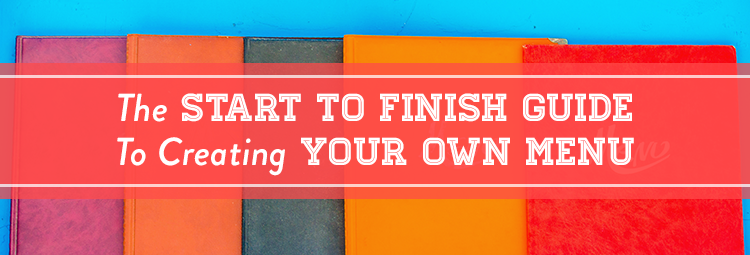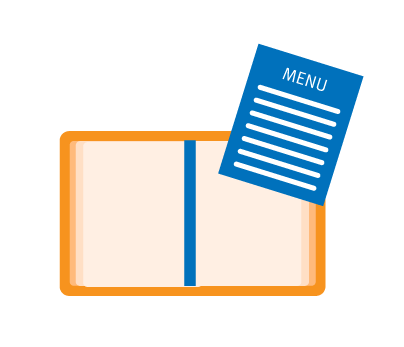The Start To Finish Guide To Creating Your Own Menu

Congratulations! You've secured your location, perfected your cuisine, and started recruiting the team that will introduce your restaurant to the world. Now, it's time to tie it all together with an official menu. Designing your restaurant's new menu may not be as exciting as putting together your list of dishes, but menus play a very important role in creating and transforming restaurants. After all, first impressions are important for any business, but presentation is a deal-breaker in the food service industry.
Why is Menu Design So Important?
If you know the expression "your eyes are bigger than your stomach", you know that food consumption isn't just about taste. Color, symmetry, readability, and other design elements have distinct psychological effects, and they will influence your customers' dining decisions. For example, playing down prices and emphasizing cocktail choices will encourage diners to spend more.
In fact, according to an article in Restaurant Startup & Growth, menu design has similar psychological effects as window displays that help stores sell merchandise. The right menu design will draw positive attention to your restaurant's drinks and dishes. As a result, it may increase your overall revenue, encourage higher checks per diner, improve your brand recognition, and even secure guest loyalty.

Step 1: Include Key Menu Elements
Menus are invaluable marketing tools because they give you multiple opportunities to customize and complement the dining experience. As you plan the basic design of your menu, appeal directly to your customers by considering these six main factors:
Taste
Does the food taste good? This might sound obvious, but it's important for the quality of your dishes to match or exceed the expectations that your menu sets.
Variety
Are there enough choices? If your restaurant specializes in one specific kind of food, such as pizza or seafood, try to offer at least one alternative. Pasta, salads, and vegetarian options are commonplace now. Groups won't choose to meet at your restaurant unless there's something for everyone.
Appearance
Different colors and shapes will make your menu more visually appealing. As you arrange your photos, make sure you alternate different color palettes and plate shapes. Of course, everything pictured should also look delicious.
Nutrition
Does your food have nutritional value? Do you have low-calorie options for health-conscious diners? Is every food group represented? Consider including nutritional information on your menus.
Production Methods
The menu should take your kitchen into consideration. Can your staff prepare everything on the menu? If most of your dishes require the same cooking equipment, make sure you have enough to handle high demand. Preparation space is also important.
Price
Your price range will depend on the type of restaurant you open, but it's important to have some flexibility within that window. Set prices for all your menu items, and make sure there are differences within each category.
During this process, you'll also need to decide which type of menu is right for your restaurant. From casual à la carte to fancy prix fixe, your menu should fall into one of eight main design categories.

Step 2: Know Your Personality
Your restaurant is essentially its own unique brand. Does that brand have a personality? Do you know what it is? Everything from the sign outside to the receipts should reflect that personality, but the menu is one of the most important forms of expression. If your restaurant is elegant and sophisticated, your menu should be too. If your restaurant is laid back and casual, your menu should match that ambiance.
It might help to sit down and write a list of adjectives that describe your restaurant. What mood do you want to create? How do you want your customers to feel? How would you describe your food? Take all of these descriptors into consideration as you design the format of your menu.

Step 3: Decide How to Create your Menu
After you settle on the basics, you need a way to bring your vision to life. Today, there are multiple ways to create your own menu. The following production methods are the most common:
- Online Templates – Browse free and cheap online templates to save time and money.
- By Hand – If you have the time and talent, you can create your own menu by hand. Get started with some helpful layout resources.
- Hired Designer – Choose from a pool of highly qualified menu designers for one-on-one attention. This option may get more costly, but it's a valuable investment.
Design Agency – Vigor is a restaurant branding agency we featured on our blog, and there are many similar agencies that handle menus professionally.

Step 4: Print Your Menus
After you finalize your menu design, take a few days to make sure it's perfect. You might notice a formatting error or realize a photo would look better on a different page, and you won't want to correct mistakes after printing multiple copies. You also need to pick your printing methods.
We recommend outsourcing this step of the process. Printing companies have high-quality, heavy-duty equipment that outshines your personal printer. They also use high-quality ink and paper that will look professional to customers. Instead of wasting time and ink on low-budget menus, ask an expert to print them.

Step 5: Add Menu Covers
You're not done just yet! Now that you have a beautiful new menu that showcases your cuisine and captures your restaurant's personality, it's time to protect your investment. Paper is fragile, and even heavy duty cardstock won't last long around drinks and food. Enhance your design and prolong the life of your menus by investing in affordable menu covers.
Quality Menu, Quality Restaurant
If you want your diners to order more drinks, visit more often, or try certain dishes, you must put thought into the way you display their options. As you plan, create, print, and protect your restaurant's new menus, pay attention to every detail. The ideal menu will achieve your business goals while meeting all your customers' needs and expectations.
Categories
Recent Posts
- Why Re-Branding Your Restaurant Is The Key to Providing a Better Customer Experience
- The Ultimate Guide To Restaurant Menu Fonts
- The Top Resources To Help You Design Your Own Menu
- Crafting The Perfect Wine List
- 5 Restaurant Blogs That Will Help You Make More Money In 2016
- Are Secret Menu's The Secret Sauce To Avid Fans
- Infographic - Reasons For Keeping The Tipping System
- Why Tipping Is Better For Diners And Servers
- How To Manage Your Online Reviews: The Good And The Bad
- Next Level Restaurant Branding Featuring Nice Branding Agency
- The Start To Finish Guide To Creating Your Own Menu
- 10 Restaurants Really Cooking With Facebook Marketing
- 6 Things You Can Do Today To Boost Your Restaurants Brand
- 8 Menu Types You Should Know About
- Next Level Restaurant Branding Featuring: Vigor
- Are Restaurant Loyalty Programs Worth It?
- 7 Restaurants Doing Dining Differently
- Judging a Restaurant By Its Menu
- Three Major Tips for Effective Restaurant Management
- 6 Tips to Get More People into Your Restaurant
